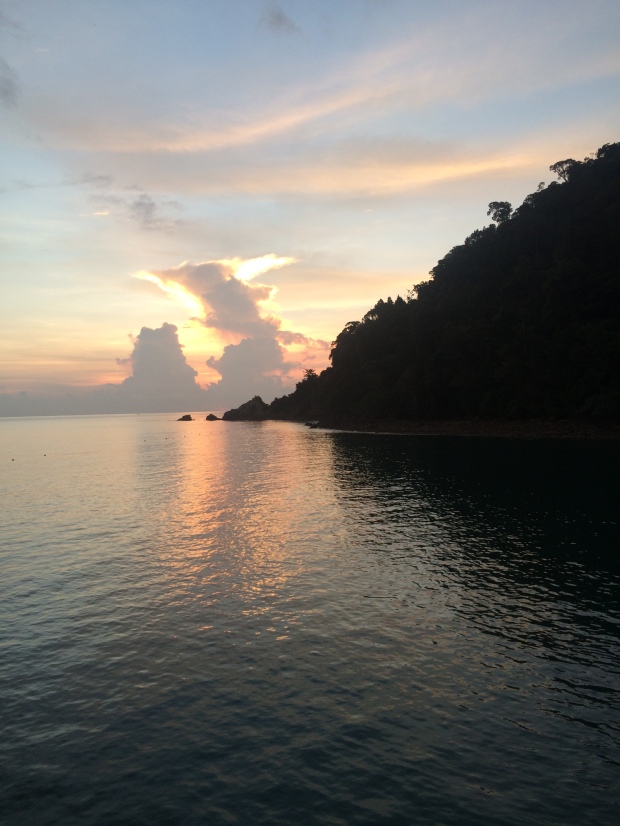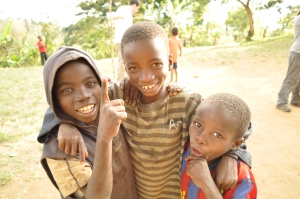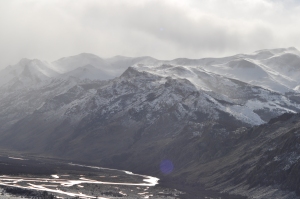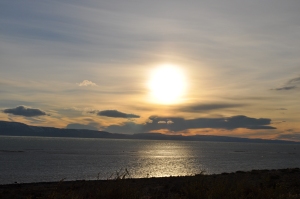
Photo by F Wiltshire
A.B.C: Annapurna. Base. Camp. Nepal is synonymous with the mighty mount Everest and one often thinks of Everest when Nepal is mentioned. The tallest mountain in the world attracts hundreds of tourists each year attempting to reach base camp or even summit. Famous for its starring role in ‘Into Thin Air’ among many other books, documentaries and films. However, in October 2014, it was Annapurna that stepped onto the main stage when blizzards and avalanches in the area brought tragedy claiming the lives of 43 people.

Annapurna
Photo by F Wiltshire
By this point I’d already booked my flights to trek in the same area and despite warnings from well-meaning friends, decided to go anyway. Sometimes in taking a risk we make the best discoveries and have real, enriching experiences; this however, was a very real risk.
For a week, we had trekked every day through a variety of beautiful and varied terrain. Carved out arable land where vast hills had steps cut into the sides. Rich, thick forests full of fusia pink rhododendron trees giving way to a darker jungle like forest, shrouded by a thick and varied

The forests of the Annapurna Conservation Area.
Photo by F Wiltshire
canopy of trees. Eventually, the forest thinned out and the mighty mountains of the Annapurna range became visible. Winding, steep steps led both up and down the mountain paths. It’s hard to put an exact number on the number of steps climbed but I would be sure to put it into the hundreds, at least – it made my legs burn at any rate. On reaching a small town called Dovan, standing at an elevation of 2500m the valley seemed to rise even steeper and the mountains finally gave you a glimpse of the task ahead. The lush, green hills were now replaced by dark, jagged snow dappled mountains that seem to converge conspiratorially, barely shrouding the Annapurna range that lay intimidatingly behind. The famous fishtail peak of Machhapuchhre poked out beyond the dark gateway, jagged, gleaming and snow-capped. The clouds hung low casting a further shadow over the darkness that lay ahead and it’s hard to believe that the mountain paths are penetrable enough to walk through. I certainly had the sense that the next few days were not going to be easy and I was starting to understand how small and insignificant I am in the face of these expansive forces of nature.

Photo by F Wiltshire
The following day saw us climbing and descending endless stone-stepped paths and for some of the journey we were led back through mountain forests.

Winding mountain paths.
Photo by F Wiltshire
As we climbed, the temperature took a noticeable fall and it felt as if the darkness was closing in again. I looked over my shoulder and noticed that as the green hills of the valley were disappearing, the billowing grey clouds were descending and appeared to be chasing us on our climb. This is, of course, ridiculous, but it added to the growing sense of nature’s power. Maybe not so ridiculous after all, those eminent clouds grew darker and it began to snow. This snow continued throughout the day and the fear of a repeat of last night’s blizzard up at Machhapuchhre base camp was becoming more real. As we continued, we passed a sign that read ‘Avalanche Risk Area’ and then stumbled upon a huge area of snow that had fallen as an avalanche maybe weeks before. Again, the reminders of Mother Nature’s power served to push us on quicker to base camp.
As the altitude rose, the upward climbs became much harder and I noticed that I became short of breath more quickly and was having to will my legs to keep moving. As we continued to climb, the snow came thicker and faster and visibility was lower.

Photo by F Wiltshire
Every now and again, I would stop, look around and find myself completely in awe of the scenery that surrounded me, at times I felt overwhelmed by the sheer scale of the mountains. The final uphill climb to M.B.C was hard going as the altitude sucked our breath and energy and this was furthered by the heavy snowfall. Walking now became an effort as we had to use our poles to pull us up through the thick snow. By the time we reached M.B.C, neither Annapurna nor Machhapuchhre were visible and the blue roof of base camp luckily poked out of the thickening snow as a sign of hope.

Photo by F Wiltshire
The communal area of M.B.C was becoming increasingly jam packed full of climber and trekkers of varying nationalities. As the various groups desperately tried to keep warm in the plummeting temperatures, the anticipation and excitement of tomorrow’s trek to Annapurna base camp was audible. This was heightened by the fact that the heavy snowfall, somewhat uncharacteristic for this time of year, began to lay doubt in our minds as to whether getting to A.B.C would even be possible. However, as night wore on and sleep evaded us due to altitude sickness, the snow gave us no hope of relenting and our dreams of climbing further to A.B.C seemed to be slipping further away with each passing hour.
4 am. Pitch black. I slept in all my clothes last night and in amongst the shivering and what seemed hallucinogenic dreams of altitude sickness, I must have slept….somehow. I opened the door to a clear night sky and waited, apprehensively, for signs of life among my fellow trekkers. Sure enough, people started to emerge and climbing groups mobilised for an early morning advance to base camp. Despite all the doubt and apprehension, it was happening. Yes, I felt like my head was stuck in a vice and yes, the snow was up to my knees but there was no way that that was going to stop me. Not now.
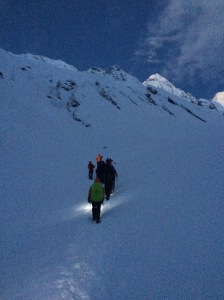
Photo by F Wiltshire
We slowly edged forward, one breathless step at a time following the thin stream of light from our head torches. Gradually as night faded and dawn arose, the incredible, crisp outlines of Machhapuchhre and Annapurna came into view and once again I felt in awe of nature’s mighty power. Each time I managed to look up, I saw a stream of light from our head torches and fresh, powdery knee deep snow. The pain I felt from altitude sickness was now overtaken by my desire to get to base camp no matter what. I had to concentrate on each step and each swing of the pole, almost meditatively moving forward one count at a time. Stopping was not an option.
After an hour and 45 minutes, the sun was up and light ricochet off Annapurna’s jagged peak.
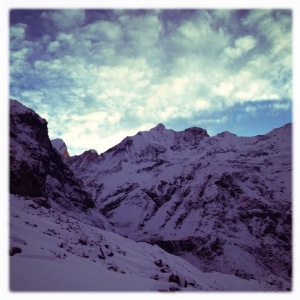
Photo by F Wiltshire
Bright, white light also rebounded off the crisp, fresh snow and it was hard to remember that it was still only 6am.
On reaching the Annapurna base camp sign, weary climbers suddenly regained composure and found the energy for numerous photos and celebrations to mark their achievement.

Photo by F Wiltshire
The atmosphere was certainly jovial and a far cry from the feelings of pain and intense concentration of an hour earlier. Even though we had reached base camp, we had a little further to go and as the excitement and adrenaline waned, despite the bright sun light, energy was draining. We walked up to a precipice overlooking one of Annapurna’s glaciers.
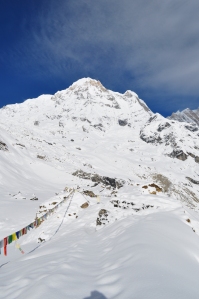
Photo by F Wiltshire
We now stood a good 20 meters or so above the glacier and in places the drop was sheer and we needed to keep our wits about us, despite our exhaustion. Here, beautiful prayer flags swept forward towards Annapurna’s peak as this was the original base camp sight. The brightness of the morning only enhanced the incredible silvers, blues and bright whites of this incredible mountain range. Up above, helicopters headed over to Annapurna 2 and in the distance, the roar of avalanches only served to remind us that much of natures beauty comes great risk and while we had now made it to our goal, we had to descend back through the avalanche risk area, on a warm day after heavy snow fall. Alarm bells rang, echoing Octobers tragedy. We were swiftly on our way back to MBC to collect equipment and beat a hasty descent. However, we were lucky and made it back down to Dovan safely, very privileged to have witnessed such an incredible sight that will remain with us for ever.

Photo by F Wiltshire


